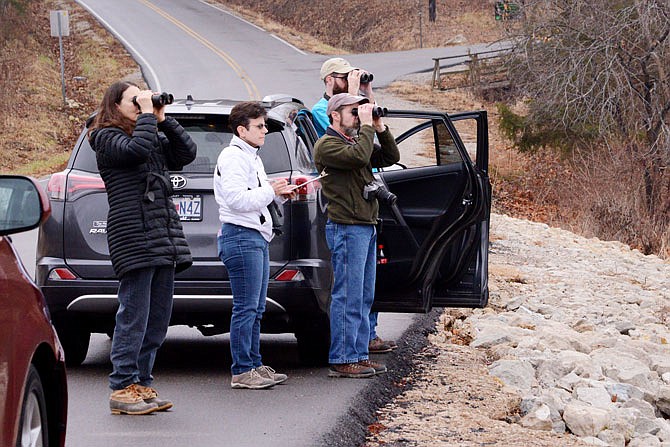A Toyota Highlander crept its way along deserted roads in Callaway County on a foggy morning Saturday as the people inside gazed out the windows - sometimes rolled up, sometimes down - looking for the flutter of wings and listening for wild screeches or songs.
Celeste Koon, the driver, said birding is like fishing; sometimes there's a lot, and sometimes there's nothing.
The nothingness of the landscape - a mist-filled grey sky, the industrial facades of Jefferson City Memorial Airport and the city's sewage treatment plant, bare trees, muddy fields, a stretch of washed-out road alongside a breached levee and land buried in coarse river sand - belied the variety of life on the wing.
There, and in the wooded habitat areas to the north between Missouri 94 and Holts Summit, were eagles, hawks, a harrier, songbirds, bluebirds, sparrows, crows, blackbirds, cardinals, blue jays, woodpeckers, robins and Carolina wrens, among others.
Koon and passengers Rick Thom and Janet Haslerig have been counting birds for years, but Thom said a lack of experience should not deter people from participating in the National Audubon Society's annual Christmas Bird Count.
The Audubon Society's 120th annual Christmas Bird Count is underway through Jan. 5, and the Jefferson City area count on Saturday was part of it through the River Bluffs Audubon Society chapter.
The one-day, individual area counts that together make up the larger bird census effort across the United States, Canada and other countries in the Western Hemisphere enlists thousands of volunteers as citizen scientists to tally how many and of what kind of birds they see and hear.
There are other counts, but "It's the one you should go on," Thom said, adding "some surveys are not this laid back," as other bird counts are very stringent about how much time must be spent at a particular location.
The group of birders in the Highlander was one of several Saturday, each group in charge of counting the birds in one of five slices of a circle 15 miles in diameter centered on the Capitol.
About 15-20 people had gathered earlier in the morning at Hy-Vee in Jefferson City for breakfast, before setting out to their respective slices of the bird-counting area pie.
"Obviously, if you're a birder, you have to have a good, decent pair of binoculars," Betty Richey said, adding a book that identifies birds is the other essential item to have.
However, "we try to help novices," Thom said later in the Highlander - by lending binoculars, as he did.
Interested bird-watchers with less experience are also paired with more experienced birders.
"You don't have to be an expert to have fun," Koon said.
She said the data compiled in the counts - while only a snapshot of one area on one day - is useful over time because, over multiple years, it can help identify trends.
The Audubon Society has an online tool that lets users look at trends revealed by Christmas Bird Count data for specific species. The red-tailed hawk, for example, has had a population increase of about 1.11 percent per year in Missouri.
However, the population of eastern meadowlark has declined across the eastern, southern and central United States - with a decrease of about 2.65 percent per year in Missouri. Field sparrows have declined at about 3.09 percent each year in Missouri.
Those two species are among the about three dozen that are part of a bird conservation plan organized this year by the Missouri Department of Conservation.
A separate study on North American birds published this year in the journal Science found birds' population on the continent has declined by 3 billion, or 29 percent, since 1970.
"This loss of bird abundance signals an urgent need to address threats to avert future avifaunal collapse and associated loss of ecosystem integrity, function and services," according to the study's abstract.
The bird counters Saturday wouldn't know the tallies from the Jefferson City area until they got together that night to do the number-crunching over a potluck dinner of chili and soup - hosted at Koon's home.
Like people flocking to hot food to beat the cold, Thom said birds that can migrate already have this time of year, save for the stragglers. Eagles and ducks need access to water that's not frozen over to find food. The weather in the region will also affect what's noticeable in counts - a cold front passing through to the north will push birds south.
People interested in bird counts and birding who can't find the time to participate in the Christmas Bird Count need not feel excluded, though.
Steve and Regina Garr said at breakfast at Hy-Vee they haven't participated as much as they would have liked because they have their Birds-I-View bird feed store to run.
However, they mentioned the Great Backyard Bird Count; the next one is planned for Feb. 14-17. More details are available at www.audubon.org/conservation/about-great-backyard-bird-count.
Regina Garr also mentioned "The Big Sit!" bird count event in October.
People interested in the River Bluffs Audubon chapter can get on the chapter's mailing list for free to find out about programs and field trips by contacting Koon at [email protected]. The chapter's email address is [email protected]. Jane Frazier is the president.
On the web
More information about the Christmas Bird Count is available at www.audubon.org/conservation/join-christmas-bird-count.

